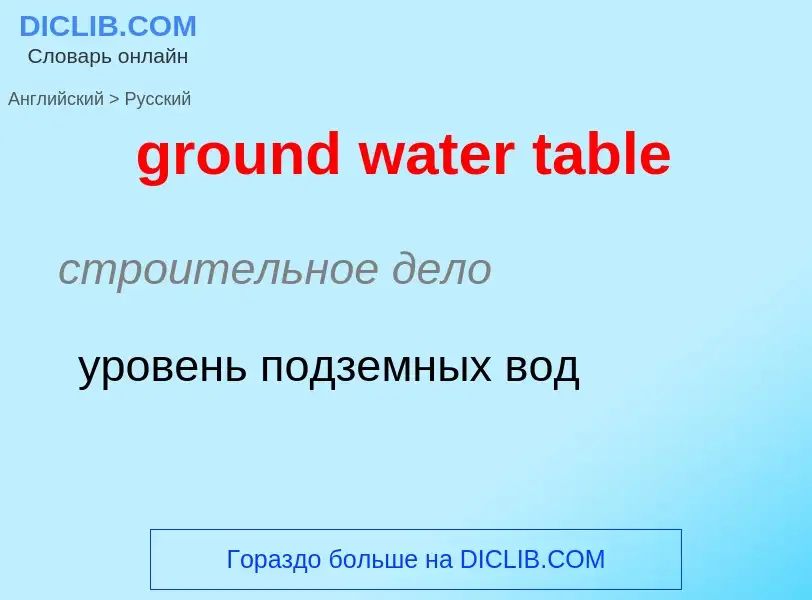Translation and analysis of words by ChatGPT artificial intelligence
On this page you can get a detailed analysis of a word or phrase, produced by the best artificial intelligence technology to date:
- how the word is used
- frequency of use
- it is used more often in oral or written speech
- word translation options
- usage examples (several phrases with translation)
- etymology
ground water table - translation to russian
строительное дело
уровень подземных вод
Definition
Wikipedia
Groundwater is the water present beneath Earth's surface in rock and soil pore spaces and in the fractures of rock formations. About 30 percent of all readily available freshwater in the world is groundwater. A unit of rock or an unconsolidated deposit is called an aquifer when it can yield a usable quantity of water. The depth at which soil pore spaces or fractures and voids in rock become completely saturated with water is called the water table. Groundwater is recharged from the surface; it may discharge from the surface naturally at springs and seeps, and can form oases or wetlands. Groundwater is also often withdrawn for agricultural, municipal, and industrial use by constructing and operating extraction wells. The study of the distribution and movement of groundwater is hydrogeology, also called groundwater hydrology.
Typically, groundwater is thought of as water flowing through shallow aquifers, but, in the technical sense, it can also contain soil moisture, permafrost (frozen soil), immobile water in very low permeability bedrock, and deep geothermal or oil formation water. Groundwater is hypothesized to provide lubrication that can possibly influence the movement of faults. It is likely that much of Earth's subsurface contains some water, which may be mixed with other fluids in some instances.
Groundwater is often cheaper, more convenient and less vulnerable to pollution than surface water. Therefore, it is commonly used for public water supplies. For example, groundwater provides the largest source of usable water storage in the United States, and California annually withdraws the largest amount of groundwater of all the states. Underground reservoirs contain far more water than the capacity of all surface reservoirs and lakes in the US, including the Great Lakes. Many municipal water supplies are derived solely from groundwater. Over 2 billion people rely on it as their primary water source worldwide.
Use of groundwater has related environmental issues. For example, polluted groundwater is less visible and more difficult to clean up than pollution in rivers and lakes. Groundwater pollution most often results from improper disposal of wastes on land. Major sources include industrial and household chemicals and garbage landfills, excessive fertilizers and pesticides used in agriculture, industrial waste lagoons, tailings and process wastewater from mines, industrial fracking, oil field brine pits, leaking underground oil storage tanks and pipelines, sewage sludge and septic systems. Additionally, groundwater is susceptible to saltwater intrusion in coastal areas and can cause land subsidence when extracted unsustainably, leading to sinking cities (like Bangkok)) and loss in elevation (such as the multiple meters lost in the Central Valley of California). These issues are made more complicated by sea level rise and other changes caused by climate changes which will affect the water cycle.

![Jennings]], [[Florida]], going into a [[sinkhole]] leading to the [[Floridan Aquifer]] groundwater Jennings]], [[Florida]], going into a [[sinkhole]] leading to the [[Floridan Aquifer]] groundwater](https://commons.wikimedia.org/wiki/Special:FilePath/AlapahaRiver2002.jpg?width=200)
![water balance]] of the aquifer water balance]] of the aquifer](https://commons.wikimedia.org/wiki/Special:FilePath/Aquifersalt.jpg?width=200)
![Groundwater may be extracted through a [[water well]] Groundwater may be extracted through a [[water well]]](https://commons.wikimedia.org/wiki/Special:FilePath/Burg Zusameck 5.jpg?width=200)
![Center-pivot irrigated]] fields in [[Kansas]] covering hundreds of square miles watered by the [[Ogallala Aquifer]] Center-pivot irrigated]] fields in [[Kansas]] covering hundreds of square miles watered by the [[Ogallala Aquifer]]](https://commons.wikimedia.org/wiki/Special:FilePath/Crops Kansas AST 20010624.jpg?width=200)
![[[Waterborne diseases]] can be spread via a groundwater well which is contaminated with fecal pathogens from [[pit latrine]]s [[Waterborne diseases]] can be spread via a groundwater well which is contaminated with fecal pathogens from [[pit latrine]]s](https://commons.wikimedia.org/wiki/Special:FilePath/Groundwater Contamination Latin America Sm.png?width=200)
![Families collecting water from a water well in [[Niger]]. Families collecting water from a water well in [[Niger]].](https://commons.wikimedia.org/wiki/Special:FilePath/Niger, Margou (13), water well with tree.jpg?width=200)
![A woman pumps water from a handpump in her village in [[Sindh]], Pakistan A woman pumps water from a handpump in her village in [[Sindh]], Pakistan](https://commons.wikimedia.org/wiki/Special:FilePath/Providing clean water and flood-resistant shelter in Sindh (5950788649).jpg?width=200)
![Ukrainian]] [[village]] Ukrainian]] [[village]]](https://commons.wikimedia.org/wiki/Special:FilePath/Shipot.jpg?width=200)
